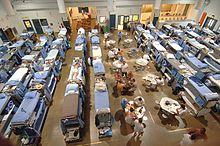
Decarceration in the United States involves government policies and community campaigns aimed at reducing the number of people held in custody or custodial supervision. Decarceration, the opposite of incarceration, also entails reducing the rate of imprisonment at the federal, state and municipal level.[1] As of 2019, the US was home to 5% of the global population but 25% of its prisoners.[2] Until the COVID-19 pandemic, the U.S. possessed the world's highest incarceration rate: 655 inmates for every 100,000 people,[3] enough inmates to equal the populations of Philadelphia or Houston.[4] The COVID-19 pandemic has reinvigorated the discussion surrounding decarceration as the spread of the virus poses a threat to the health of those incarcerated in prisons and detention centers where the ability to properly socially distance is limited. As a result of the push for decarceration in the wake of the pandemic, as of 2022, the incarceration rate in the United States declined to 505 per 100,000, resulting in the United States no longer having the highest incarceration rate in the world, but still remaining in the top five.
- ^ "Decarceration Law and Legal Definition | USLegal, Inc". definitions.uslegal.com. Retrieved May 11, 2020.
- ^ Ye Hee Lee, Michelle (July 7, 2015). "Yes, U.S. locks people up at a higher rate than any other country". The Washington Post.
- ^ "Ranking: most prisoners per capita by country 2019". Statista. Retrieved May 11, 2020.
- ^ Kann, Drew (June 29, 2018). "The US still incarcerates more people than any other country". CNN. Retrieved April 29, 2020.
